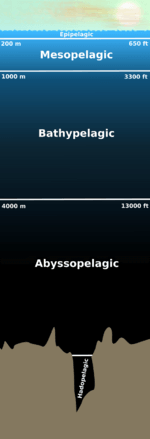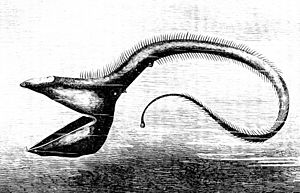Deep sea fish facts for kids
Deep-sea fish (or mesopelagic fish) are fish that live in the darkness below the sunlit surface waters of the sea.
Contents
Common deep-sea fish
The lanternfish is, by far, the most common deep-sea fish. Other deep sea fishes include:
- flashlight fish,
- cookiecutter shark,
- bristlemouths,
- anglerfish,
- viperfish, and
- some species of eelpout.
Environment
Deep-sea organisms generally live in the layer that is from (1000–4000 m deep) to (4000–6000 m deep). No light penetrates this area of the ocean. These zones make up about 75% of the inhabitable ocean space.
The deep sea is also an extremely hostile environment, with temperatures that rarely exceed 3 °C (37 °F) and fall as low as −1.8 °C (29 °F) (with the exception of hydrothermal vent ecosystems that can exceed 350 °C, or 662 °F), low oxygen levels, and pressures between 20 and 1000 atm (between 2 and 100 MPa).
Hydrostatic pressure increases by 1 atm for every 10 m in depth. Deep-sea organisms have the same pressure within their bodies as is exerted on them from the outside, so they are not crushed by the extreme pressure.
Characteristics
The fish of the deep-sea have adapted to survive in this region.
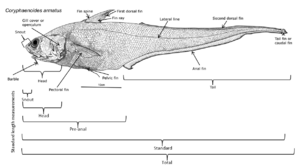
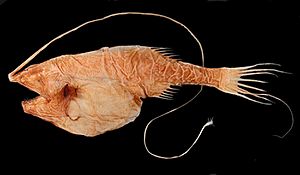
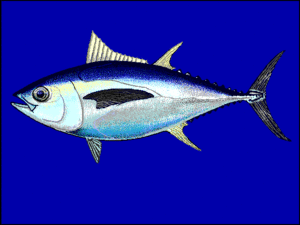
Eyesight
Since there is no natural illumination, deep-fish cannot rely solely on their eyesight for locating prey and mates and avoiding predators. That's why many of these organisms are blind and rely on their other senses, such as sensitivities to changes in local pressure and smell, to catch their food and avoid being caught.
Those that aren't blind have large and sensitive eyes that can use bioluminescent light. These eyes can be as much as 100 times more sensitive to light than human eyes. Rhodopsin (Rh1) is a protein found in the eye’s rod cells that helps animals see in dim light. While most vertebrates usually have one Rh1 opsin gene, some deep sea fish have several Rh1 genes, and one species, the silver spinyfin (Diretmus argenteus), has 38.
Coloration
To avoid predation, many species are dark to blend in with their environment.
Mesopelagic fish usually lack defensive spines, and use colour to camouflage themselves from other fish. Ambush predators are dark, black or red. Since the longer, red, wavelengths of light do not reach the deep sea, red effectively functions the same as black. Migratory forms use countershaded silvery colours.
On their bellies, they often display photophores producing low grade light. For a predator from below, looking upwards, this bioluminescence camouflages the silhouette of the fish. However, some of these predators have yellow lenses that filter the (red deficient) ambient light, leaving the bioluminescence visible.
Bioluminescence
Many deep-sea fish are bioluminescent. Bioluminescent organisms are capable of producing light biologically through the agitation of molecules of luciferin, which then produce light. This process must be done in the presence of oxygen.
More than 50% of deep-sea fish, as well as some species of shrimp and squid, are capable of bioluminescence. About 80% of these organisms have photophores – light producing cells that contain luminous bacteria. Some of these photophores contain lenses, much like those in the eyes of humans, which can intensify or lessen the light.
The ability to produce light only requires 1% of the organism's energy and has many purposes. It is used to:
- search for food and attract prey, like the anglerfish;
- claim territory through patrol;
- communicate and find a mate, and
- distract or temporarily blind predators to escape.
Also, in the areas where some light still penetrates, some organisms camouflage themselves from predators below them by illuminating their bellies to match the colour and intensity of light from above so that no shadow is cast. This tactic is known as counter-illumination.
Body tissues
The deeper a fish lives, the more jelly-like its flesh and the more minimal its bone structure is. They reduce their tissue density through high fat content, reduction of skeletal weight. Also, they are slower and less agile than surface fish.
| Species by pelagic zone | |
|---|---|
| Many species move daily between zones in vertical migrations. In this table they are listed in the middle or deeper zone where they are regularly found. |
|
| Zone | Species and species groups include... |
| Epipelagic |
|
| Mesopelagic | Lanternfish, opah, longnose lancetfish, barreleye, ridgehead, sabretooth, stoplight loosejaw, marine hatchetfish |
| Bathypelagic | Principally bristlemouth and anglerfish. Also fangtooth, viperfish, black swallower, telescopefish, hammerjaw, daggertooth, barracudina, black scabbardfish, bobtail snipe eel, unicorn crestfish, pelican eel, flabby whalefish. |
| Benthopelagic | Rattail and brotula are particularly abundant. |
| Benthic | Flatfish, hagfish, eelpout, greeneye eel, stingray, lumpfish, and batfish |
| Comparative structure of pelagic fishes | ||||
|---|---|---|---|---|
| Epipelagic | Mesopelagic | Bathypelagic | deep sea benthic | |
| muscles | muscular bodies, ossified bones, scales, well developed gills and central nervous systems, and large hearts and kidneys. | poorly developed, flabby | ||
| skeleton | strong, ossified bones | weak, minimal ossification | ||
| scales | yes | none | ||
| nervous systems | well developed | lateral line and olfactory only | ||
| eyes | large and sensitive | small and may not function | variable (well developed to absent) | |
| photophores | absent | common | common | usually absent |
| gills | well developed | |||
| kidneys | large | small | ||
| heart | large | small | ||
| swim bladder | vertically migratory fish have swim bladders | reduced or absent | variable (well developed to absent) | |
| size | usually under 25 cm | variable, species greater than one meter are not uncommon | ||
Food
Since there is no light in the deep sea (aphotic), there is a lack of primary producers. As sunlight cannot reach them, deep-sea organisms rely heavily on marine snow as an energy source. Marine snow is a continuous shower of mostly organic debris falling from the upper layers of the water column.
Marine snow includes dead or dying plankton, protists (diatoms), fecal matter, sand, soot and other inorganic dust. The "snowflakes" grow over time and may reach several centimetres in diameter, travelling for weeks before reaching the ocean floor. However, most organic components of marine snow are consumed by microbes, zooplankton and other filter-feeding animals within the first 1000 m of their journey.

Some deep-sea fish have long feelers to help them locate prey or attract mates in the pitch black of the deep ocean. The deep-sea angler fish in particular has a long fishing-rod-like adaptation protruding from its face. On its end there is a bioluminescent piece of skin that wriggles like a worm to lure its prey.
Some must consume other fish that are the same size or larger than them and they need adaptations to help digest them efficiently. Great sharp teeth, hinged jaws, disproportionately large mouths, and expandable bodies are a few of the characteristics that deep-sea fishes have for this purpose. The gulper eel is one example of an organism that displays these characteristics.
Mesopelagic plankton feeders have small mouths with fine gill rakers, while the piscivores have larger mouths and coarser gill rakers.
Migration
Most deep-sea fish make daily vertical migrations, moving at night into the higher (epipelagic) zone, to feed on zooplankton, and returning to the depths for safety during the day. To move upwards, they use a swim bladder. The swim bladder is inflated when the fish wants to move up. As the fish ascends, the pressure in the swim bladder must adjust to prevent it from bursting. When the fish wants to return to the depths, the swim bladder is deflated. Some mesopelagic fishes make daily migrations through the thermocline, where the temperature changes between 50 °F (10 °C) and 69 °F (20 °C), thus displaying considerable tolerances for temperature change.
Endangered species
A 2006 study by Canadian scientists has found five species of deep-sea fish – blue hake, spiny eel – to be on the verge of extinction due to the shift of commercial fishing from continental shelves to the slopes of the continental shelves, down to depths of 1600 m. The slow reproduction of these fish – they reach sexual maturity at about the same age as human beings – is one of the main reasons that they cannot recover from the excessive fishing.
Interesting facts
- Most deep-sea are not capable of surviving in laboratory conditions. Any attempts to keep them in captivity have led to their deaths. Deep-sea organisms contain gas-filled spaces (vacuoles). Gas is compressed under high pressure and expands under low pressure. Because of this, these organisms have been known to blow up if they come to the surface.
- Some deep-sea creatures, such as the lanternfish, ridgehead, marine hatchetfish, and lightfish families are sometimes termed pseudoceanic, becuase they group around structural oases, seamounts and continental slopes.
- Sonar operators during World War II were puzzled by what appeared to be a false sea floor 300–500 m deep at day, and less deep at night. This turned out to be due to millions of marine organisms, most particularly small mesopelagic fish. Their swim bladders that reflected the sonar. These organisms migrate up into shallower water at dusk to feed on plankton. The layer is deeper when the moon is out, and can become shallower when clouds pass over the moon. This phenomenon has come to be known as the deep scattering layer.
Images for kids
-
The stoplight loosejaw has a lower jaw one-quarter as long as its body. The jaw has no floor and is attached only by a hinge and a modified tongue bone. Large fang-like teeth in the front are followed by many small barbed teeth.
-
The stoplight loosejaw is also one of the few fishes that produce red bioluminescence. As most of their prey cannot perceive red light, this allows it to hunt with an essentially invisible beam of light.
See also
 In Spanish: Fauna abisal para niños
In Spanish: Fauna abisal para niños
- Census of Marine Life
- Deep ocean water
- Deep sea
- Deep sea communities
- Deep water fish
- Demersal fish
- Pelagic fish



